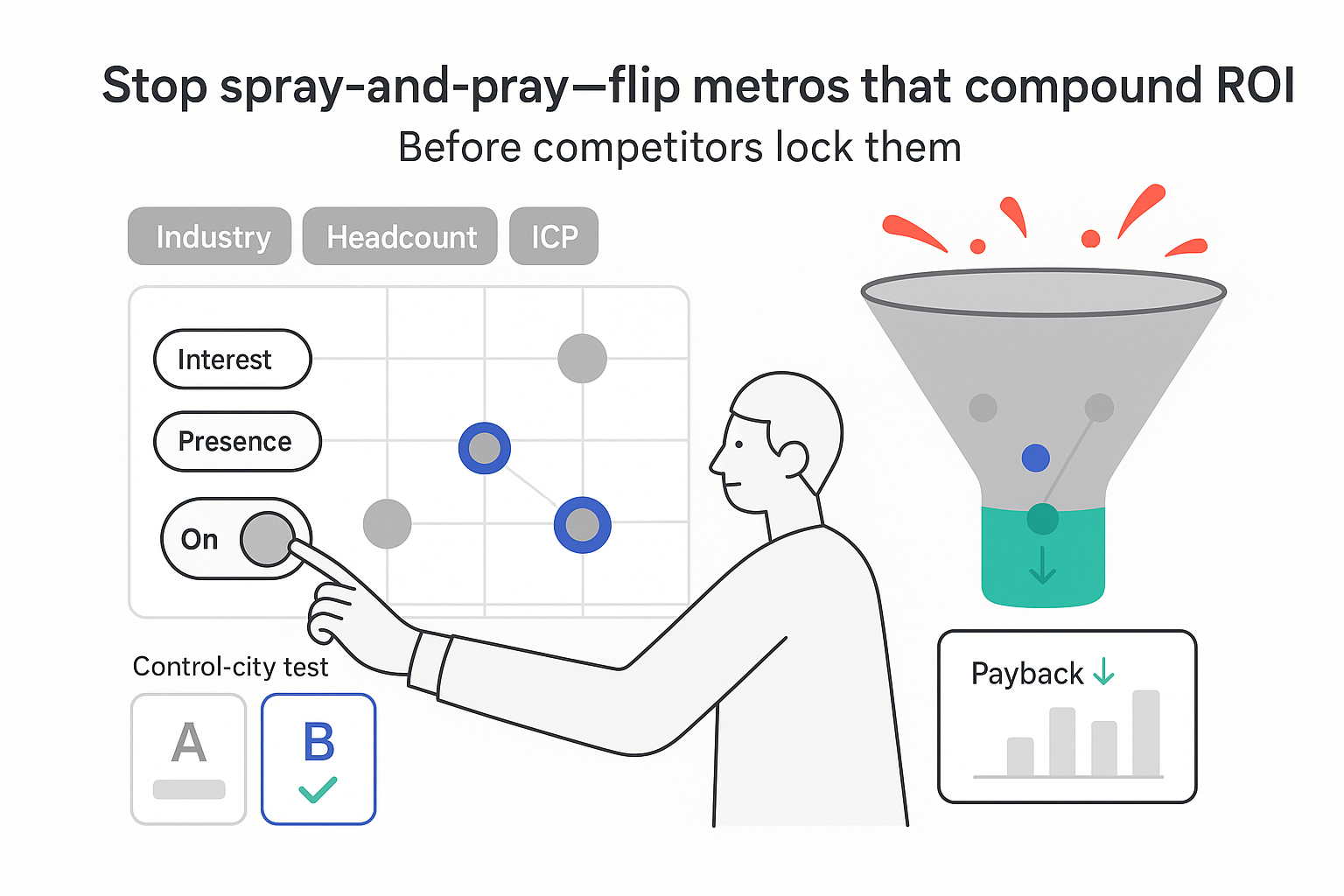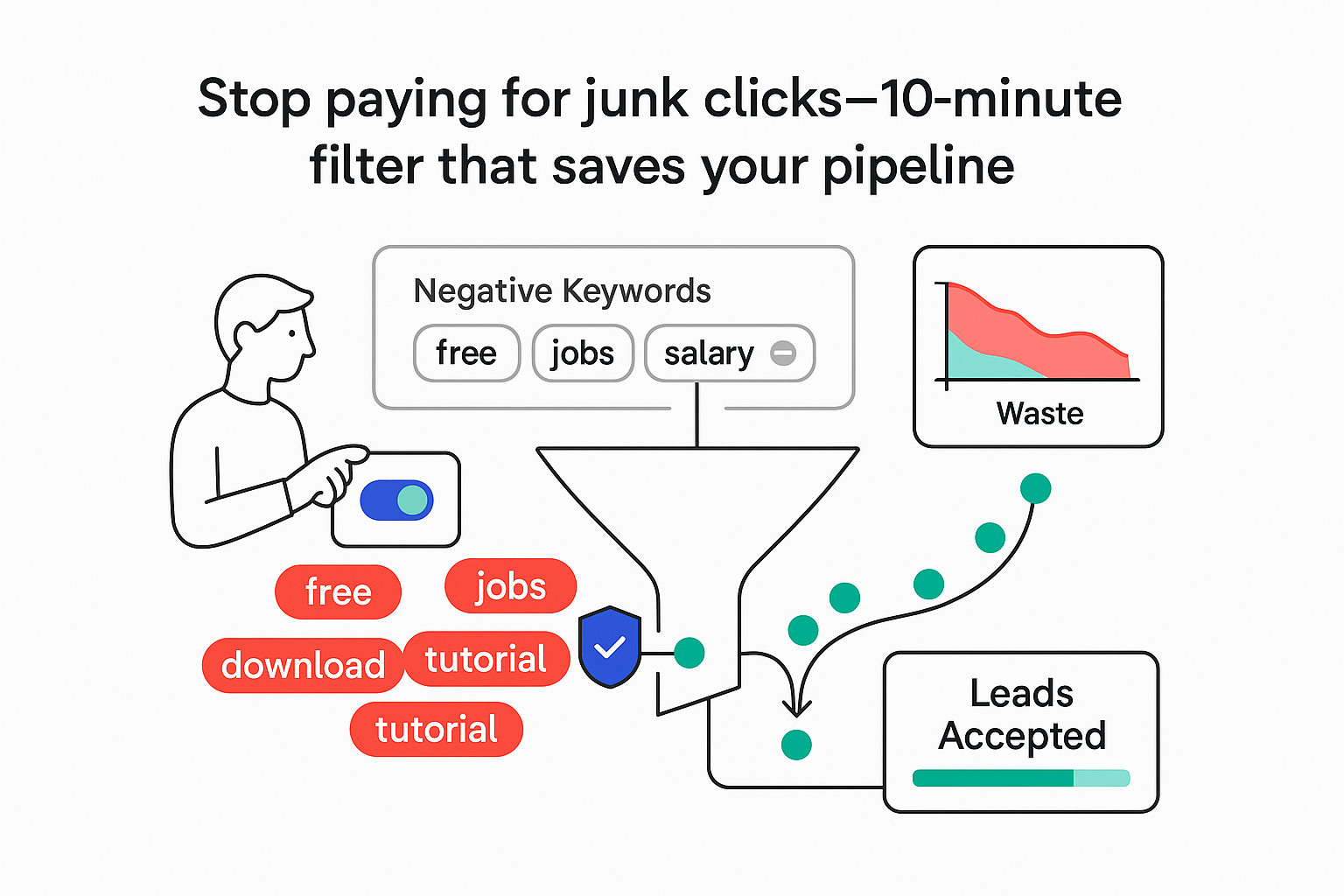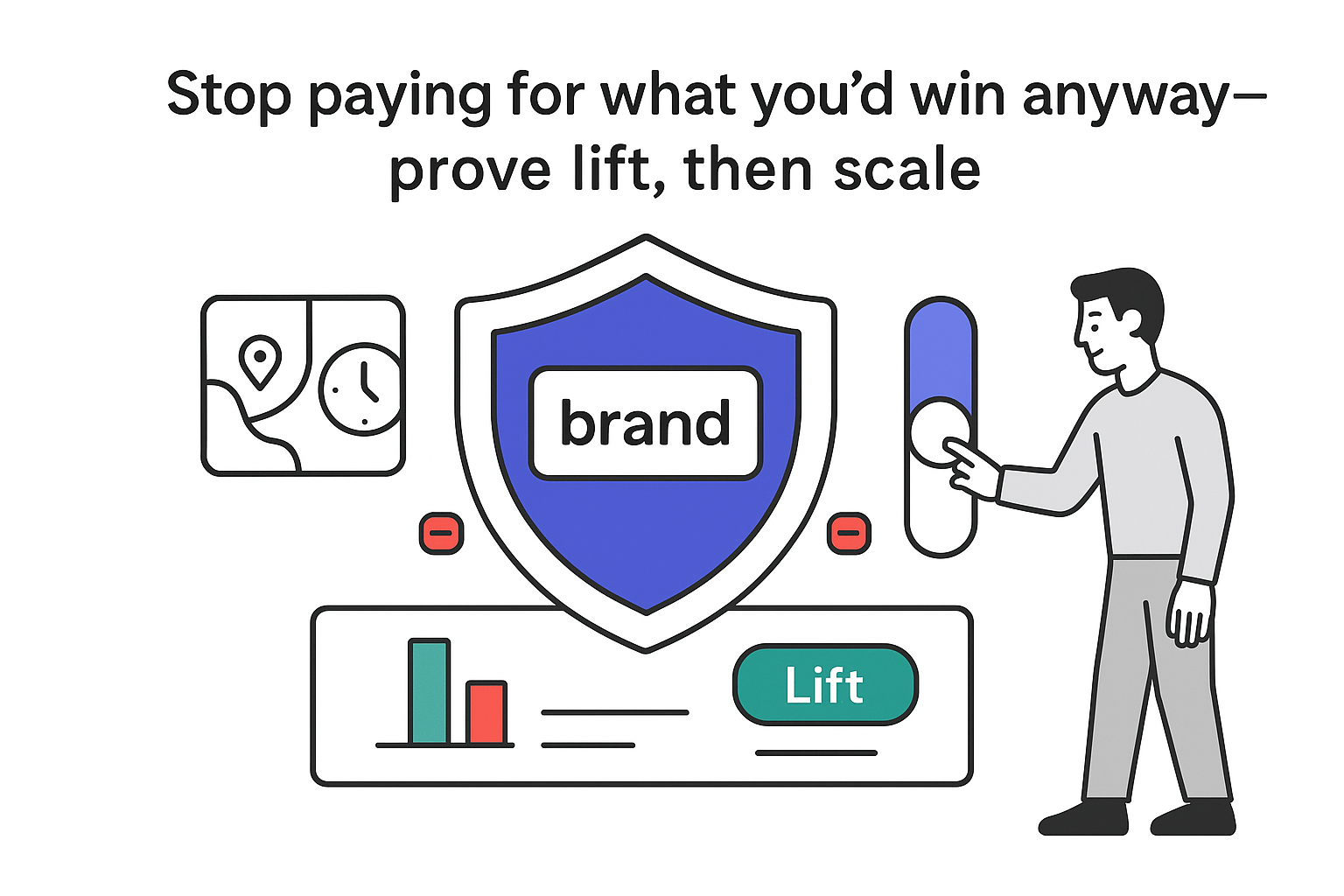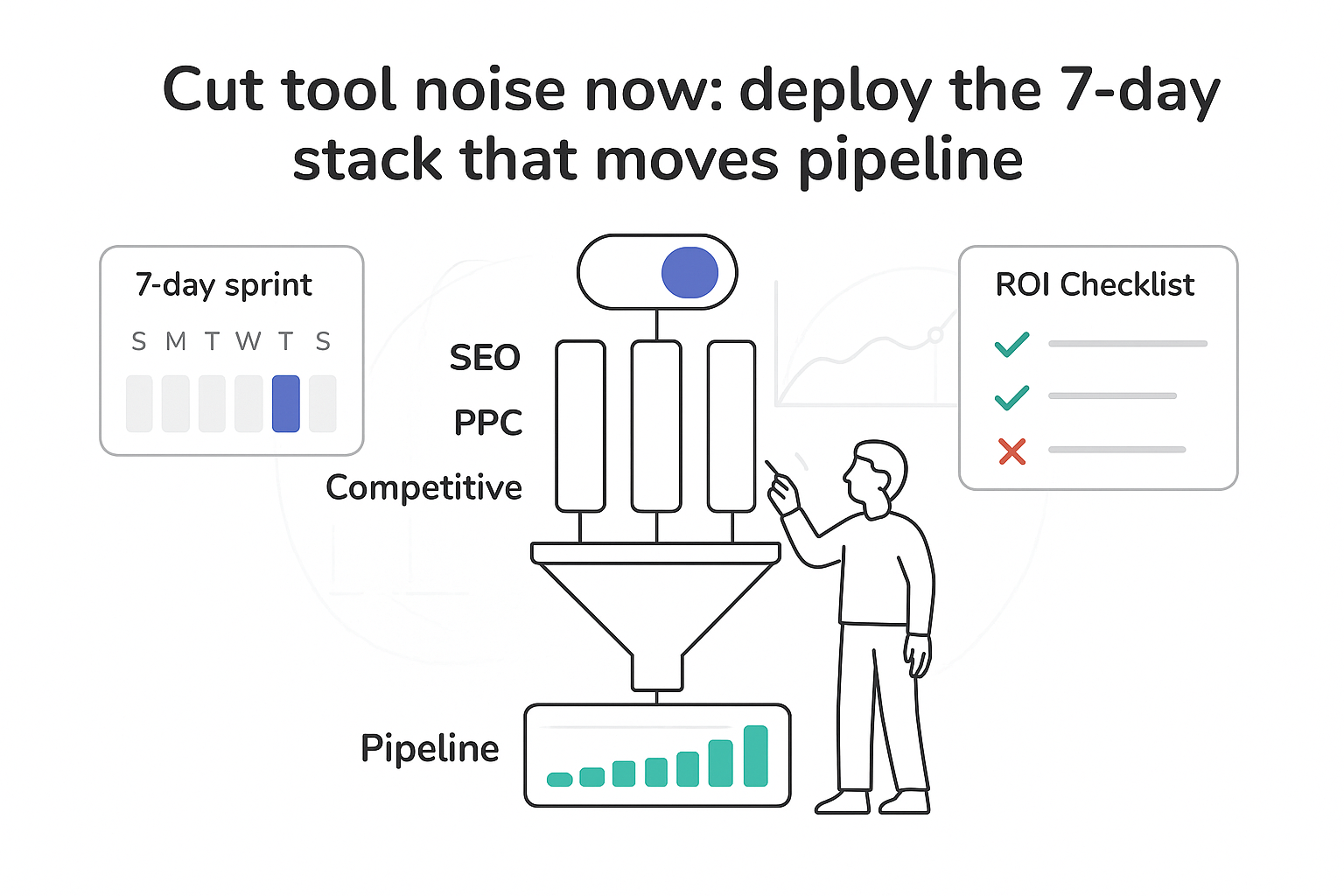I want marketing to pull its weight. Not just clicky charts and fancy dashboards, but proof that every dollar I put in brings real revenue back out. That is what marketing ROI exists to answer. The trick is making it simple enough to use week after week, yet precise enough to guide serious budget decisions. I will keep the math clean and the system practical so it runs without me hovering.
Calculate marketing ROI
I use one baseline formula that keeps everyone honest: ROI percent equals attributed revenue minus marketing cost, divided by marketing cost, times 100.
Written out: ROI percent = ((Attributed revenue − Marketing cost) ÷ Marketing cost) × 100
If I want to tighten the rigor, I swap “attributed revenue” for “attributed gross profit,” so the numerator reflects revenue minus cost of goods sold. The denominator stays “marketing cost.”
A quick three-step start any B2B services team can run this month:
- Attribute pipeline to campaigns. In the CRM, I tag every opportunity with a single primary campaign and a person-sourced field. I also track campaign influence so I can compare single-touch to multi-touch later.
- Convert pipeline into revenue using real sales math. For each campaign, I track SQLs, win rate, average contract value or lifetime value, and the average sales cycle. I forecast revenue and mark actual revenue once deals close.
- Add all-in costs. I include media, content and creative, contractor fees, and internal time. I align costs with the period of the revenue I am crediting, with a trailing view if sales cycles push across quarters.
B2B services example with round numbers:
- Campaign: Paid search for IT consulting
- Period: Q2
- SQLs: 60
- Win rate: 20 percent
- ACV: 40,000
- Projected revenue: 60 × 0.20 × 40,000 = 480,000
- Actual closed revenue recorded by Q4: 360,000
- Marketing cost: 90,000
- ROI percent using actuals: ((360,000 − 90,000) ÷ 90,000) × 100 = 300 percent
That 300 percent ROI means three dollars back for every dollar in, after costs. It is not the same as ROAS. ROAS looks only at ad spend and revenue, useful for channel tests. ROI includes all costs, which creates real accountability and fair cross-channel comparisons.
I add two checks that B2B leaders watch closely:
- CAC payback. CAC equals total sales and marketing cost to acquire a customer. Payback months equals CAC divided by gross margin per month. Many B2B services aim for payback within 12 months or faster.
- LTV to CAC ratio. I target about 3 to 1 as a baseline. If gross margin is high and churn is low, I can push harder. If I sell one-off projects, I keep a more conservative bar.
A simple structure I rebuild in a spreadsheet:
- Tab 1 Campaign cost ledger: Date, campaign, channel, fixed cost, media cost, headcount hours, hourly rate, total cost.
- Tab 2 Pipeline: Opportunity ID, account, sourced campaign, influenced campaigns, SQL date, stage, amount, close date, won or lost.
- Tab 3 ROI model: Campaign, SQLs, win rate, ACV or LTV, projected revenue, actual revenue, total cost, ROI percent, CAC, LTV to CAC, payback months.
A small funnel chart (impression → MQL → SQL → revenue) next to the model makes the leak visible to everyone.
What marketing ROI is (and is not)
Marketing ROI measures how much profit my marketing creates compared with what I spent. It matters because budget allocation is a competitive sport. Clear ROI lets me keep what works, stop what drags, and forecast with confidence. With disciplined ROI, I can:
- Justify spend for leadership with numbers they can audit.
- Set channel and campaign targets grounded in margins.
- Compare paid, organic, events, and partners on equal footing.
- Establish baselines so the next quarter starts with a realistic plan.
Attribution shapes ROI. I pick a model and stay consistent:
- Single-touch sourced. I credit the first campaign that brought the lead. It is simple to run and clean for sourced pipeline. See common attribution models.
- Multi-touch influenced. I spread credit across key milestones like first visit, conversion, opportunity creation, and close won. It is better for strategy and trickier to maintain. Learn how multi-touch attribution models can be combined with MMM.
B2B services introduce nuances that skew ROI if I ignore them:
- Sales cycles can run 60 to 180 days or more. I align spend and returns across quarters and keep a trailing view of impact.
- Multiple stakeholders mean multiple touches. I expect early research from non-buyers and late-stage visits from buyers. Influence grows over time, which is why content and brand awareness matter even when attribution looks thin.
- Expansion and referrals affect lifetime value. If services renew or expand, I build LTV into the model so top-of-funnel work gets fair long-term credit.
In short, marketing ROI is a decision tool. I keep it clear, fair, and tied to revenue a CRM can prove.
Challenges that distort marketing ROI
If it were easy, every dashboard would match finance. I run into a few common snags when I measure marketing ROI:
- Multi-touch journeys. A buyer hears a podcast, sees a LinkedIn post, Googles the brand, then talks to a partner. Who gets credit?
- Long cycles. Spend in Q2 can win deals in Q4. Short windows undercount impact. Long windows can hide waste.
- Offline touchpoints. Events, print, direct mail, out-of-home, and calls drive visits that look like direct or brand search.
- Dark social. DMs, community chats, text threads, and word of mouth rarely show in analytics.
- Brand lag. Awareness today can convert in two quarters. The model needs memory.
- Data silos and messy CRM fields. Inconsistent UTM tags, duplicate contacts, unclear lead sources, and missing opportunity fields break the math.
- Biased attribution windows. Seven-day windows favor paid social. Ninety-day windows can over-credit top of funnel.
Practical fixes for cleaner data
I avoid jargon and mandate the basics:
- Define UTM taxonomy. I document source, medium, campaign, and content values, lock them, and audit weekly.
- Integrate marketing automation and CRM. One system becomes the source of truth for opportunities and revenue. Consider unified marketing measurements to connect data.
- Track calls and numbers. Dynamic number insertion on the site routes source and keyword into the lead record.
- Govern lead source. I make primary source a required field and lock it on creation; changes go through an admin queue.
- Standardize pipeline stages. I put clear entry and exit rules on MQL and SQL stages, and I train SDRs and AEs to follow them. Here is a reference for common success metrics.
- Run matchback analyses. For offline programs, I match CRM accounts and contacts to event lists, mail drops, or households by date and city. I publish influence rules in advance.
- Report both sourced and influenced views. I use sourced ROI for accountability and influenced ROI for strategy. Side by side, the story is clearer.
- Align with finance. I agree upfront on which costs count, which margins to apply, and what attribution window I use, then hold to it.
These steps rarely feel glamorous. They do produce clean numbers. Clean numbers create faster, better decisions.
Ways I improve marketing ROI without bigger budgets
Once the plumbing works, I tune the engine. A focused plan can lift results without bigger budgets:
- Set goals and baselines. I pick a north star like pipeline generated, not just leads. I add guardrails like LTV:CAC greater than 3 and payback under 12 months.
- Count all costs. People, content, travel, event booths, vendor fees. Hiding costs only fools the model.
- Double down on bottom-of-funnel and intent pages. Solutions pages, pricing, comparison content, and industry pages that map to high-intent searches usually turn curiosity into SQLs.
- Run conversion rate optimization on key pages. Clean headlines, fast load, social proof, and clear forms - starting with pages that touch most revenue.
- Tighten qualification. Sharper ICP rules raise win rate and shorten sales cycles, which improves ROI before I spend another dollar.
- Prioritize SEO tied to revenue. Case studies with outcomes, industry use cases, and named service pages often drive meetings when rankings hold.
- Implement lead scoring. I use both fit and engagement so SDR time goes to the right people and noise drops.
- Test offers. Calendar links with pre-qualification, audit calls, calculators, or short teardown videos. The right offer shifts close rates more than another round of ad copy.
- Hold a simple reporting cadence. Weekly channel reviews, monthly ROI by campaign, and a quarterly plan-versus-actual with one owner per metric.
Small examples of quick wins:
- Move the primary CTA on solution pages above the fold and place proof nearby. SQLs often rise without more traffic.
- Shift spend from broad awareness to high-intent search for 30 days. Compare SQL quality and win rate.
- Add one qualifier on forms to filter out poor-fit industries. Sales gets time back and ROI moves.
ROI grows fastest when the team sees one number and knows who owns it. I keep it visible.
Make offline campaigns measurable
Offline is not a black box. I connect it to the CRM and make it report like any other channel. For more guidance on integrating offline and online marketing activities to work together across online and offline channels, see these resources, and this overview on How to Measure Offline Marketing ROI?
- Create unique URLs or vanity domains per campaign. I use simple paths and always append UTMs. I route to a page built for that audience.
- Print QR codes on mailers, booths, and posters. Codes land on pages tied to that physical touch with UTMs baked in and a short form or phone number that tracks. Try a QR Code generator and consider Beaconstac’s QR Code Tracking for analytics.
- Use dynamic phone numbers. I assign source-level numbers to print, radio, or billboards and feed call recordings and outcomes into the CRM.
- Tie offers to campaigns. A free assessment for direct mail or a waived onboarding fee for event meetings - coded and time-bound - to keep credit clean.
- Map everything to CRM source fields. Campaign, medium, creative, and location should roll to the opportunity and revenue line.
- Reconcile with declared attribution. I ask people how they heard about us and compare it to what tracking captured. Then I adjust influence weights.
When I connect offline to CRM with these basics, I can compare a trade show to paid search with a straight face and a real number.
Geo-targeted landing pages
I take the city or region I am targeting offline and match it online. I create pages tied to each market. The QR on the poster in Austin should land on brand.com/austin with UTMs already set. The headline matches the local message they just saw. If I serve multiple sectors, I swap in the right case studies by industry for that city.
I add dynamic number insertion so Austin visitors see a unique phone number that maps to the Austin campaign. I pass the number, page, and UTM values into hidden form fields, then write them into the contact and opportunity in the CRM. That way, when a deal closes, the revenue remains tied to Austin, not just to generic direct traffic.
When possible, I mirror images or copy used in local print or out-of-home. The small echo builds confidence and lowers bounce. It also helps me spot which message performed when I review each city’s conversion rate. Read this article on how to build effective landing pages.
Promotional codes
Codes are simple and powerful when they are structured the right way. I give each channel a clean prefix and a time-bound suffix - for example, MAILNYC23 or EXPOSEA24. If phone calls are a big part of the funnel, I include a unique extension that callers press to reach the right team.
Three safeguards keep codes trustworthy:
- Enforce one-time use and an expiry date so codes do not leak into other channels.
- Map the code to a campaign record inside the CRM, not just to a discount field on an invoice.
- Review code redemptions in the monthly ROI report and compare them to tracked sessions from those campaigns. If redemptions exceed tracked sessions, I check for cross-channel contamination or manual entry errors.
Codes do not have to mean discounts. I can map a code to a free training slot, a faster onboarding window, or a premium support tier for the first month. The point is attribution, not price cutting.
Just ask
Sometimes the cleanest answer is the most human one. I add a required form field that asks “How did you hear about us?” and teach SDRs to ask the same question on discovery calls. I use a standardized multi-select list with an open text option. I keep the list short and clear: search, referral, partner, event, social, podcast, ad, other.
Then I reconcile two views once a month:
- Declared attribution. What people say. This often captures dark social and offline sources that tracking misses.
- Tracked attribution. What UTMs and call tracking show. This often captures the digital entry point.
When they disagree, I look for patterns. Maybe buyers say “podcast” while analytics shows “direct.” That tells me the podcast drives branded navigation, not immediate form fills. I adjust influence weights and share the insight with content and media so the next round of spend lines up with reality.
Closing thought that doubles as a rule of thumb: if I can connect a touch to a person in the CRM and then connect that person to revenue, I can measure it. If the connection is shaky, I strengthen the plumbing with UTMs, phone tracking, codes, and governance. Marketing ROI stops being a guess and starts acting like a compass the whole team can follow.







.svg)